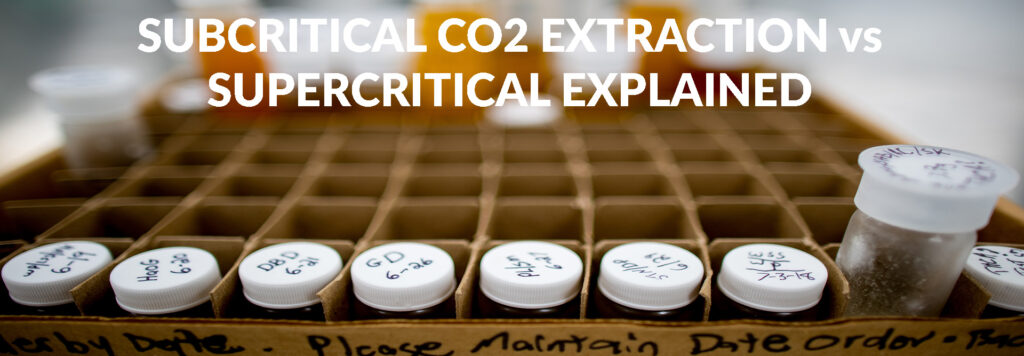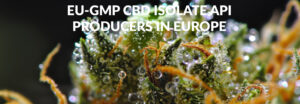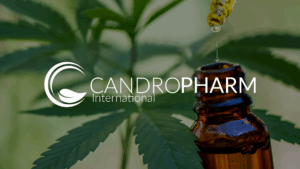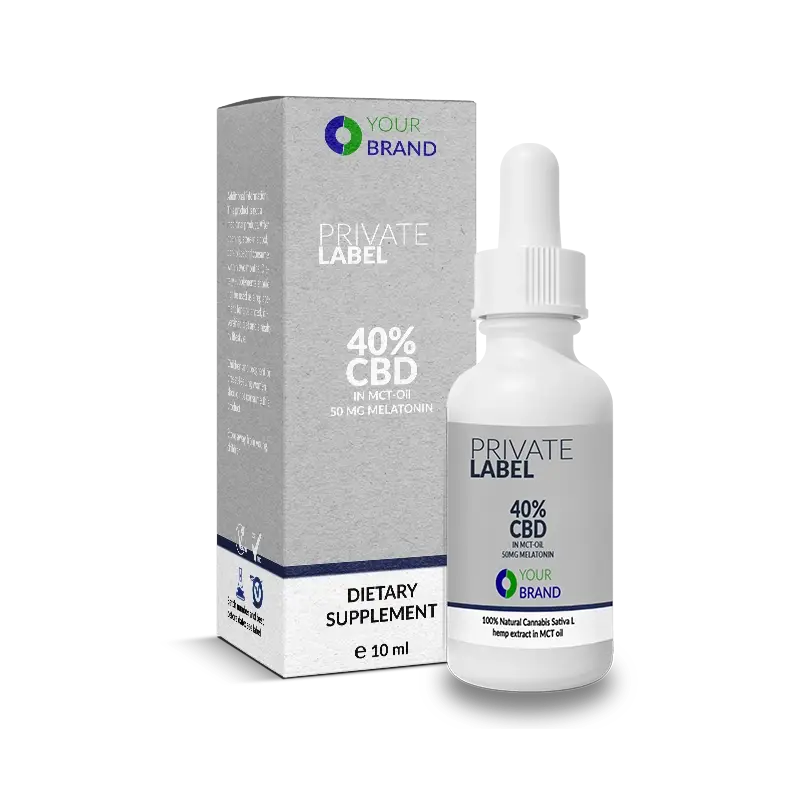Subcritical CO2 Extraction vs Supercritical Explained
Why Candropharm choose Subcritical CO2 Extraction method for their products?
When it comes to CBD extraction, the method matters more than most people think. Candropharm International picked subcritical CO2 extraction for their CBD distillates, and honestly, there’s a solid reason for it. This choice makes them stand out from other companies that go with supercritical methods.
Subcritical CO2 extraction keeps fragile terpenes and sensitive compounds intact. Supercritical methods? They often destroy these, so you end up with a less complete, less therapeutically valuable CBD product. Subcritical CO2 extraction uses lower temperatures and pressures, which protects these delicate plant compounds. Supercritical extraction, on the other hand, uses more heat and pressure, and that can change or get rid of these beneficial elements altogether.
Let’s dig into how these two extraction methods actually differ—temperature, pressure, yield—and why Candropharm’s move to subcritical extraction results in superior CBD distillates. Knowing these differences? It really helps you make smarter choices about CBD. Extraction method should absolutely be on your radar when you’re deciding what to buy.
Key Takeaways
- Subcritical CO2 extraction uses lower temperatures and pressures, so it preserves terpenes and therapeutic compounds that are easily lost.
- Supercritical methods crank up the yield, but the high heat and pressure can destroy sensitive plant compounds.
- Subcritical extraction is a strategic pick for premium CBD distillates, even if it means higher equipment costs and longer processing times.
Comparing Subcritical and Supercritical CO2 Extraction
The main differences between subcritical and supercritical CO2 extraction come down to how they operate and what they pull out of the plant. Both CO2 extraction methods have their place and can actually work well together if you use them right.
Differences in Pressure and Temperature
Subcritical CO2 extraction runs at lower pressures and temperatures than supercritical. You’ll usually see subcritical setups working below 1,073 psi and under 31°C. Pretty gentle, all things considered.
Supercritical CO2 extraction is a lot more intense. Most supercritical CO2 extraction processes need pressures between 1,600-4,000 PSI and temperatures above 31°C.
| Parameter | Subcritical | Supercritical |
|---|---|---|
| Pressure | <1,073 psi | 1,600-4,000 psi |
| Temperature | <31°C | >31°C |
| Processing Time | Longer | Shorter |
With these lower settings, subcritical extraction is great for protecting delicate compounds that just wouldn’t survive the harsher conditions of supercritical extraction.
Implications for Trichomes and Compound Selectivity
Subcritical CO2 extraction is much more selective when you’re after specific compounds from trichomes. The gentler process keeps volatile terpenes and temperature-sensitive molecules—the stuff that really gives you a full spectrum product—intact.
Honestly, subcritical methods shine when you want to pull out lighter compounds first. You can do fractionated extraction, collecting different compounds at different stages. Pretty neat, right?
Supercritical extraction is just more aggressive. The high pressure and heat turn CO2 into a super-solvent that grabs a wide range of compounds all at once.
This approach can wreck delicate terpene profiles, though. On the plus side, it’s great at extracting cannabinoids and heavier compounds that subcritical might leave behind.
Extraction Efficiency and Yield
Subcritical CO2 extractions usually give you smaller yields because they’re gentler. The process takes longer and isn’t as efficient if you’re just after volume.
But here’s the thing: the quality of subcritical extracts often makes up for the lower yield. You get a better terpene profile and more selective extraction of what you actually want from the plant.
Supercritical methods pull out more material in less time. The solvent is so aggressive, it just grabs everything it can.
That speed and yield come at a cost, though. Supercritical extraction isn’t picky, so you end up pulling out stuff you don’t want—meaning more post-processing to clean things up.
Solvent Properties and Purity
In subcritical settings, CO2 acts more like a gas but with some extra dissolving power. It’s a milder process, and that helps keep the compounds closer to their original state.
The extracts from this method usually need less refining. You get a cleaner product right off the bat, with fewer unwanted extras tagging along.
Supercritical CO2 is denser, almost like a liquid but with the flow of a gas. It’s a serious solvent, getting deep into the plant material and pulling out a lot.
Both supercritical and subcritical CO2 extraction are eco-friendly and don’t leave nasty solvent residues in the final product. That’s a big plus for both.
Advantages of Subcritical CO2 Extraction Over Supercritical for CBD
Subcritical CO2 extraction brings some real perks for CBD, especially when you want to keep delicate plant compounds and a pure product. It’s a gentler approach, so you get better terpene retention and fewer unwanted byproducts.
Superior Retention of Sensitive Terpenes
Subcritical CO2 extraction uses lower temps and pressures, which is perfect for saving heat-sensitive terpenes that boost CBD oil’s therapeutic effects. These compounds are pretty fragile and break down with too much heat.
The gentler process keeps terpenes from degrading. We usually see retention rates between 85-95%, while supercritical methods often drop down to 60-75%.
Key temperature differences:
- Subcritical: 10-35°C
- Supercritical: 31-80°C
That temperature control really matters if you care about the entourage effect. Terpenes like myrcene, limonene, and pinene stick around through the whole process.
Full-spectrum plant products really benefit from subcritical extraction because the terpene profile stays close to what’s in the original plant. You get CBD with more therapeutic potential and a better taste, too.
Cleaner Extracts With Minimal Unwanted Byproducts
Subcritical extraction is more selective, so you get cleaner CBD oil with fewer contaminants. Lower pressure means you don’t pull out as much chlorophyll or waxes—stuff you mostly don’t want.
We notice there’s a lot less cleanup needed after extraction. A basic filter usually takes care of most impurities, so you don’t have to go through heavy refining.
Typical purity levels:
- Subcritical CBD oil: 92-97% target compounds
- Supercritical CBD oil: 85-92% target compounds
Because the extraction is more selective, you don’t have to remove as many unwanted compounds. That means more good cannabinoids, fewer problematic extras.
Chlorophyll is a real headache with supercritical methods. It gives the oil a bitter taste and adds extra processing steps, which can mess up sensitive compounds.
Eco-Friendly and Safe Production
Subcritical CO2 extraction needs less pressure—usually under 1,000 PSI, compared to 1,600-4,000 PSI for supercritical. That means it uses a lot less energy.
Lower pressure also means less strain on equipment, so machines last longer. We’re talking 30-40% less energy use per kilo of CBD extracted.
The gentler process is safer for workers, too. Less pressure means fewer risks if something goes wrong with the equipment.
Environmental perks:
- Lower carbon footprint due to reduced energy needs
- Equipment lasts longer, so less waste
- CO2 recycles completely, so there’s almost no solvent waste
CO2 is non-toxic and doesn’t leave any residue in the final CBD. No worries about chemical leftovers here.
Enhanced Product Customisation
With subcritical extraction, you can dial in exactly which compounds you want by tweaking the settings as you go. It’s possible to target specific cannabinoids and terpenes in stages.
This lets you create custom CBD oil profiles. Change up the pressure and temperature, and you’ll pull different compounds.
Customisation options:
- Start with light, terpene-rich fractions
- Move to medium, cannabinoid-focused extractions
- Do sequential runs for a layered product
You can run the same material several times, getting the most out of it without sacrificing quality. Each run pulls a different set of compounds.
By blending these different fractions, you can make CBD with specific terpene or cannabinoid ratios. That kind of fine-tuning is tough with one-shot supercritical methods.
Overview of CBD Extraction Methods
The CBD industry mostly relies on three extraction methods to get cannabidiol from hemp: CO2 extraction leads the way, while ethanol and oil-based methods fill certain niches.
CO2 Extraction Method Fundamentals
CO2 extraction is the gold standard for commercial CBD. It turns carbon dioxide into a solvent by playing with temperature and pressure.
The process breaks down into three main types: supercritical, subcritical, and mid-critical. Each one produces different cannabinoid profiles and extract textures.
Supercritical CO2 extraction runs above 31°C and over 73.8 bar. In this state, CO2 strips cannabinoids, terpenes, and more from the plant really efficiently.
Subcritical CO2 extraction keeps things cooler and less pressurised. This gentler method saves delicate terpenes and gives you a molasses-like oil, compared to the peanut butter texture you get from supercritical.
The CO2 process avoids hazardous solvent residues and cuts down on unwanted chemicals in the final product. But the equipment isn’t cheap—think £65,000 to £380,000 for a proper setup.
CO2 extraction lets you control exactly which compounds you pull out at each stage by adjusting the pressure and temperature. That’s a big deal if you want consistency and quality.
Ethanol Extraction Technique
Ethanol extraction uses alcohol to pull CBD and other cannabinoids from hemp biomass. It’s a cost-effective method that doesn’t demand pricey, specialized equipment.
This approach works because ethanol really does a great job dissolving cannabis compounds. Most processors stick with grain alcohol or high-proof ethanol for the best results.
Benefits include:
- Lower equipment costs
- Faster processing times
- High-potency distillate production
- Scalable for large operations
However, ethanol extraction needs extra safety measures—think alarm systems, gas detectors, and strict storage rules. Facilities have to follow tight regulations around flammable solvents.
This method can also pull out stuff you don’t want, like chlorophyll, so extra purification steps are often needed. Some manufacturers go for ethanol when making broad-spectrum products, but others find it less ideal for full-spectrum extracts.
After extraction, winterisation usually comes next to clean things up and hit the desired purity.
Oil Extraction and Other Alternatives
Oil extraction methods use carrier oils—olive oil is a favorite—to pull cannabinoids out with heat and time. It’s a simple process that appeals to small-scale producers and DIYers looking for straightforward extraction.
First, you decarb the hemp by heating it up, which activates the cannabinoids. Then, the plant material simmers in oil so the compounds can transfer into the carrier.
Alternative methods include:
- Dry ice extraction – makes powdered, hash-like concentrates
- Butane extraction – delivers strong concentrates but definitely needs safety precautions
- Rosin pressing – uses heat and pressure, no solvents required
Oil extraction just doesn’t match the yields of commercial methods. The products don’t last as long and have a narrower potency range.
We think these methods attract artisanal makers and folks who like traditional approaches. But, honestly, they can’t compete with the efficiency or consistency of modern CO2 or ethanol systems.
Each alternative fills its own niche in the bigger CBD extraction methods world.
What Sets Subcritical CO2 Extraction Apart at Candropharm International
Candropharm International’s subcritical CO2 extraction keeps delicate plant compounds intact while letting us fine-tune cannabinoid profiles. This gentler method protects temperature-sensitive terpenes and produces higher-quality CBD distillates than the harsher supercritical approach.
Application to CBD Distillate Production
Our subcritical CO2 process runs at lower temps and pressures than supercritical methods—usually below 31.1°C and under 1,071 psi. These conditions are just right for making CBD distillate.
It takes longer, sure, but the results are worth it. We get consistent cannabinoid profiles and avoid the thermal damage that comes with high-pressure systems.
Key operational parameters:
- Temperature: Below critical point (31.1°C)
- Pressure: Under 1,071 psi
- Duration: Extended processing time
- Yield: Lower volume, higher quality
Our equipment keeps a tight grip on environmental controls throughout extraction, so we get repeatable results every time.
This subcritical approach lets us pick and choose which compounds we want. We can target specific cannabinoids and leave the rest behind.
Preservation of Cannabinoids and Terpenes
Subcritical extraction preserves fragile stuff like essential oils and terpenes—things supercritical methods often destroy. Our process shields these compounds from heat damage.
Temperature-sensitive terpenes stay intact through the whole process. These aromatic compounds really add to the therapeutic profile of our CBD products.
Protected compounds include:
- Monoterpenes (limonene, pinene)
- Sesquiterpenes (β-caryophyllene)
- Minor cannabinoids (CBG, CBC)
- Flavonoids and phenolic compounds
The gentler subcritical process prevents delicate molecules from oxidizing. This keeps the full range of beneficial plant compounds in the extract.
We preserve the natural ratios found in hemp, which means our products offer more of that entourage effect.
Impact on CBD Product Quality
Our subcritical extraction creates CBD distillates with a molasses-like consistency—not the peanut butter texture you see with supercritical. That thicker texture signals preserved terpenes.
Final products have broader cannabinoid profiles. Our distillates hang onto minor cannabinoids that can boost therapeutic effects.
Quality advantages:
- Colour: Lighter, cleaner look
- Flavour: Natural hemp taste shines through
- Potency: Consistent cannabinoid levels
- Purity: Solvent-free extraction
Subcritical extraction gets rid of residual solvents completely. CO2 just goes back to gas, so there aren’t any harmful leftovers in our CBD products.
The process delivers pharmaceutical-grade distillates that work for all sorts of applications. Our products always meet tough standards for both medicinal and consumer markets.
Industry Considerations: Equipment, Scaling, and Hemp Strains
Maintenance needs and hemp strain differences can really affect how well subcritical CO2 extraction works. Scaling up manufacturing depends on understanding these variables and keeping product quality consistent along the way.
CO2 Extraction Equipment and Maintenance
Subcritical CO2 setups need specialized equipment built for lower pressure than supercritical systems. The main components include pumps, extraction vessels, and separators—each rated for specific pressure ranges.
Pressure Requirements:
- Subcritical: 800–1,000 PSI
- Supercritical: 1,500–5,000 PSI
Lower pressures mean less wear on seals, valves, and pumps. That translates into lower maintenance costs and longer equipment life.
Temperature control systems for subcritical operations usually keep things between 31–60°C. In our experience, these moderate temps put less stress on the system.
Maintenance Benefits:
- Seals last longer
- Pumps wear out less quickly
- Less downtime for repairs
Gentler conditions lead to fewer equipment failures. Plus, replacement parts are cheaper since they’re rated for lower pressures.
Adapting Extraction to Different Hemp Strain Characteristics
Different hemp strains have all sorts of cannabinoid and terpene profiles, and they don’t all extract the same way. We adjust our subcritical parameters based on hemp cultivar characteristics to get the best yields.
Strain-Specific Considerations:
| Strain Type | Cannabinoid Profile | Extraction Adjustments |
|---|---|---|
| High CBD | 15–20% CBD, <0.3% THC | Lower pressure, longer extraction times |
| Balanced | 8–12% CBD, moderate CBG | Medium pressure, standard timing |
| Terpene-rich | High volatile compounds | Reduced temperature, gentle processing |
CBD-heavy strains usually need longer extraction cycles at lower pressures. That way, we keep the full cannabinoid spectrum and avoid breaking things down.
Strains rich in terpenes need careful temperature management. Subcritical methods really shine here, since they run below terpene degradation points.
We tweak extraction vessel residence times based on how dense the plant material is and how many cannabinoids it contains. Denser flowers mean longer processing times.
Scalability and Consistency in Manufacturing
Scaling up subcritical CO2 operations? It’s all about getting equipment sizing and process standardization right. Industrial hemp processing gear needs to handle different batch sizes but still keep product quality locked in.
Scaling Factors:
- Extraction vessel capacity
- CO2 recirculation rates
- Processing throughput needs
Bigger operations often do better with several smaller extraction vessels instead of one giant unit. That gives more flexibility and helps keep batch-to-batch variation down.
Quality Control Parameters:
- Temperature monitoring (±2°C tolerance)
- Pressure stability (±50 PSI variance)
- Standardized extraction times
We use automated controls to keep operating parameters steady across runs. This way, we get consistent cannabinoid profiles, no matter the batch size.
Process documentation becomes super important as you scale. Standard procedures need to cover different hemp strains and seasonal changes in quality.
How hemp is grown affects raw material consistency, so extraction parameters sometimes need tweaking. Indoor-grown hemp tends to deliver more uniform cannabinoid profiles than outdoor crops, in our experience.
Frequently Asked Questions
Subcritical CO2 extraction runs at lower temperatures and pressures than supercritical, which helps preserve delicate compounds and changes the consistency of the extracts. The method you choose affects everything—terpene retention, final product purity, and more.
What advantages does subcritical CO2 extraction offer when creating CBD distillates?
Subcritical CO2 extraction protects temperature-sensitive compounds that would otherwise get damaged by harsher extraction. Lower temperatures keep fragile terpenes and essential oils intact.
This process gives extracts with richer flavor profiles. We notice better retention of the plant’s natural aromas.
Subcritical extraction works especially well for full-spectrum products since it keeps the entire cannabinoid profile. The gentler process helps maintain the entourage effect.
How do subcritical and supercritical CO2 extraction methods differ in terms of their impact on CBD quality?
Temperature really makes the difference here. Supercritical extraction uses temps above 31.10°C and pressures over 1,071 psi, while subcritical stays much milder.
Subcritical methods produce molasses-like extracts that keep more delicate compounds. Supercritical gives a peanut butter consistency and higher yields, but you lose some terpenes along the way.
The harsher supercritical process can change or destroy sensitive terpenes. We’ve seen subcritical methods do a better job preserving those volatile compounds.
Why might a company choose subcritical CO2 extraction over supercritical for CBD product manufacturing?
Companies that care about full-spectrum products usually lean toward subcritical extraction because it does a better job preserving the plant’s natural compounds. This method keeps fragile components like essential oils and terpenes intact, which can really boost the therapeutic effects—at least, that’s the idea.
There’s also a real push from the market for products that taste and smell like the original plant. More and more, people want extracts that keep those natural flavors and aromas.
The whole “entourage effect” thing also pops up a lot in these decisions. If a company believes in the benefits of the entire plant working together, they’ll probably go for subcritical extraction since it’s a bit gentler on the material.
What are the key differences in the end products when comparing subcritical and supercritical CO2 extraction?
The physical consistency you get can be pretty different depending on the method. Subcritical extraction gives you a thick, molasses-like extract, while supercritical extraction creates something more like peanut butter. Weird comparison, but it’s accurate.
The terpene content is another big difference. Subcritical extracts tend to hold onto more of those delicate, aromatic compounds that some people really care about.
But if you’re talking about yield, supercritical wins. Supercritical extraction pulls out more product and does it faster than subcritical, so it’s hard to ignore if efficiency matters to you.
Can subcritical CO2 extraction methods result in a higher purity CBD distillate compared to supercritical methods?
Purity’s a bit of a moving target—it depends on which compounds you’re measuring and what you want in the end. Both methods can get you pretty pure results, but they take different routes to get there.
Subcritical extracts usually need a few extra steps to reach distillate-level purity. The process is gentler, so you start with a more complex extract that needs a bit more refining.
On the flip side, supercritical extraction pulls out bigger molecules like chlorophyll and waxes. You’ve got to remove those through winterization, and honestly, that extra step can affect the purity of your final product.
In terms of environmental impact and safety, how does subcritical CO2 extraction compare with supercritical extraction?
Both methods rely on carbon dioxide as a solvent, so they’re a lot greener than using hydrocarbons. CO2 extraction gives you a non-toxic, eco-friendly way to make concentrates, which is a big plus in my book.
There’s a difference in energy use, though. Subcritical extraction runs at lower pressures and temperatures, so it doesn’t need as much energy. That feels like a win for efficiency.
As for safety, both methods come out looking really good. They don’t use hazardous solvents and you don’t have to worry about the explosion risks you get with hydrocarbons. That’s honestly a relief.









